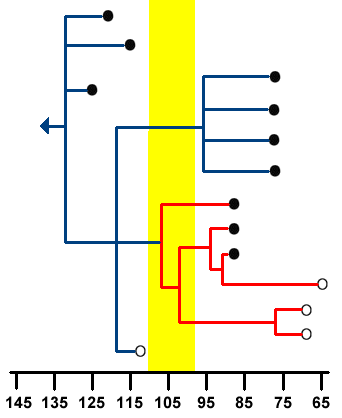Eutheria: Difference between revisions
mNo edit summary |
m fossil range template |
||
| Line 2: | Line 2: | ||
{{Taxobox |
{{Taxobox |
||
| name = Eutheria |
| name = Eutheria |
||
| fossil_range = Early [[Cretaceous]] - Recent |
| fossil_range = {{Fossil range/Sandbox|125|0}}Early [[Cretaceous]] - Recent |
||
| image=Eomaia scansoria.JPG |
| image=Eomaia scansoria.JPG |
||
| image_width = 270px |
| image_width = 270px |
||
Revision as of 21:32, 12 October 2008
| Eutheria Temporal range: Template:Fossil range/SandboxEarly Cretaceous - Recent
| |
|---|---|

| |
| Fossil of Eomaia, the oldest known eutherian | |
| Scientific classification | |
| Kingdom: | |
| Phylum: | |
| Class: | |
| Subclass: | |
| Infraclass: | Eutheria |
| Orders[1] | |
Eutheria ("true beast") are a group of mammals consisting of placental mammals plus all extinct mammals that are more closely related to living placentals (such as humans) than to living marsupials (such as kangaroos). They are distinguished from non-eutherians by various features of the feet, ankles, jaws and teeth. One of the major differences between placental and non-placental eutherians is that placentals lack the epipubic bones which are present in all other fossil and living mammals.
The earliest known fossil eutherian, Eomaia was found in Asia and is dated to the Early Cretaceous period, about 125 million years ago.
Definition
Eutherians are a group of mammals consisting of placental mammals plus all extinct mammals that are more closely related to living placentals (such as humans) than to living marsupials (such as kangaroos).[2]
There are no living non-placental eutherians, and so knowledge of their synapomorphies ("defining features") is entirely based on a few fossils – which means the reproductive features that distinguish modern placentals from other mammals cannot be used in defining the eutheria. The features of eutheria that distinguish them from metatherians, a group that includes modern marsupials, are:
- an enlarged malleolus ("little hammer")at the bottom of the tibia, the larger of the two shin bones.[2]
- the joint between the first metatarsal bone and the entocuneiform bone in the foot is offset further back than the joint between the second metatarsal and mesocuneiform bones – in metatherians these joints are level with each other.[2]
- various features of jaws and teeth.[2]
Reproductive features are also of no use in identifying fossil placental mammals, which are distinguished from other eutherians by:
- the presence of a malleolus at the bottom of the fibula, the larger of the two shin bones.[2]
- a complete mortise and tenon upper ankle joint, where the rearmost bones of the foot fit into a socket formed by the ends of the tibia and fibula.[2]
- a wide opening at the bottom of the pelvis, which allows the birth of large, well-developed offspring. Marsupials have and non-placental eutherians had a narrower opening that allows only small, immature offspring to pass through.[3]
- the absence of epipubic bones extending forwards from the pelvis, which are not found in any placental, but are found in all other mammals - non-placental eutherians, marsupials, monotremes and mammaliformes – and even in the cynodont therapsids that are closest to mammals. Their function is to stiffen the body during locomotion.[4] This stiffening would be harmful in pregnant placentals, whose abdomens need to expand.[5]
Evolutionary history
| The earliest known eutherian species is the extinct non-placental Eomaia scansoria from the Lower Cretaceous of China, dated to about 125 million years ago. Some of its fossils show thick fur. Montanalestes was found in North America, while all other non-placental eutherian fossils have been found in Asia. The earliest known placental fossils have also been found in Asia.[2] | |
† = extinct |
Notes and references
- ^ "Eutheria phylogeny". Mikko's Phylogeny Archive. Retrieved 2008-07-24.
- ^ a b c d e f g h i Ji, Q., Luo, Z-X., Yuan, C-X.,Wible, J.R., Zhang, J-P.,and Georgi, J.A. (April 2002). "The earliest known eutherian mammal". Nature. 416: 816–822. doi:10.1038/416816a. Retrieved 2008-09-24.
{{cite journal}}: CS1 maint: multiple names: authors list (link) - ^ Weil, A. (April 2002). "Mammalian evolution: Upwards and onwards". Nature. 416: 798–799. doi:10.1038/416798a. Retrieved 2008-09-24.
- ^ Reilly, S.M., and White, T.D. (January 2003). "Hypaxial Motor Patterns and the Function of Epipubic Bones in Primitive Mammals". Science. 299 (5605): 400–402. doi:10.1126/science.1074905. Retrieved 2008-09-24.
{{cite journal}}: CS1 maint: multiple names: authors list (link) - ^ Novacek, M.J., Rougier, G.W, Wible, J.R., McKenna, M.C, Dashzeveg, D.,and Horovitz, I. (October 1997). "Epipubic bones in eutherian mammals from the Late Cretaceous of Mongolia". Nature. 389: 483–486. doi:10.1038/39020. Retrieved 2008-09-24.
{{cite journal}}: CS1 maint: multiple names: authors list (link)

